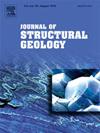Rheological inversion in high-grade metamorphic rocks: Evidence from folds, inverse folds, mullions and boudins (Bohemian Massif)
IF 2.6
2区 地球科学
Q2 GEOSCIENCES, MULTIDISCIPLINARY
引用次数: 0
Abstract
We investigated the effects of Variscan deformation on Cadomian metagranitoids and intercalated mafic sheets (amphibolite and mafic gneiss) in the Moldanubian and Moravo-Silesian units of the southeastern Bohemian Massif. Given the contrasting mechanical strength of felsic and mafic minerals, deformation is expected to be accommodated by folding and/or boudinage of the competent mafic sheets within the incompetent granitoid host. However, the studied examples show a competence inversion indicated by (1) a stronger foliation in the mafic sheets, (2) extension-parallel mullions at shortened contacts and inverse folds at extended contacts with the cusps pointing into the felsic rock, and (3) extension-parallel folding and boudinage of felsic veins within amphibolite matrix. The lobate phase boundaries in mafic and felsic rocks suggest that the competence inversion was related to a switch in the dominant deformation mechanism from dislocation to phase-boundary diffusion creep in the stability field of high-quartz (T > 650 °C). As phase-boundary diffusion is enhanced by a decreasing grain size, the fine-grained mafic rocks behaved mechanically weaker than the coarser grained felsic rocks. This inversion in viscosity occurred at ca. 332 Ma (U-Pb on titanite) and might have been also supported by the basal slip of biotite within the mafic sheets.
高品位变质岩的流变反演:来自褶皱、逆褶皱、棱纹和界纹的证据(波西米亚地块)
研究了瓦里斯坎变形对波希米亚地块东南部摩尔多瑙河单元和莫拉沃-西里西亚单元卡多米亚变质玄武岩和插层基性片麻岩(角闪岩和基性片麻岩)的影响。考虑到长英质和基性矿物的不同机械强度,预计变形将通过在不称职的花岗岩类宿主中折叠和/或束缚称职的基性片材来调节。然而,研究实例表明,其能力反转表现为(1)基性片理作用较强,(2)接触面较短的伸展-平行竖纹,接触面较宽的反向褶皱,尖端指向长英质岩,(3)角闪岩基质中长英质脉的伸展-平行褶皱和边界。基性岩和长英质岩的叶状相界表明,能力反演与高石英稳定场中主要变形机制由位错向相界扩散蠕变转变有关。650°C)。随着晶粒尺寸的减小,相界扩散增强,细粒基性岩的力学性能弱于粗粒长英质岩。这种粘度反转发生在约332 Ma(钛铁矿上的U-Pb),可能也受到基性薄片内黑云母基底滑移的支持。
本文章由计算机程序翻译,如有差异,请以英文原文为准。
求助全文
约1分钟内获得全文
求助全文
来源期刊

Journal of Structural Geology
地学-地球科学综合
CiteScore
6.00
自引率
19.40%
发文量
192
审稿时长
15.7 weeks
期刊介绍:
The Journal of Structural Geology publishes process-oriented investigations about structural geology using appropriate combinations of analog and digital field data, seismic reflection data, satellite-derived data, geometric analysis, kinematic analysis, laboratory experiments, computer visualizations, and analogue or numerical modelling on all scales. Contributions are encouraged to draw perspectives from rheology, rock mechanics, geophysics,metamorphism, sedimentology, petroleum geology, economic geology, geodynamics, planetary geology, tectonics and neotectonics to provide a more powerful understanding of deformation processes and systems. Given the visual nature of the discipline, supplementary materials that portray the data and analysis in 3-D or quasi 3-D manners, including the use of videos, and/or graphical abstracts can significantly strengthen the impact of contributions.
 求助内容:
求助内容: 应助结果提醒方式:
应助结果提醒方式:


